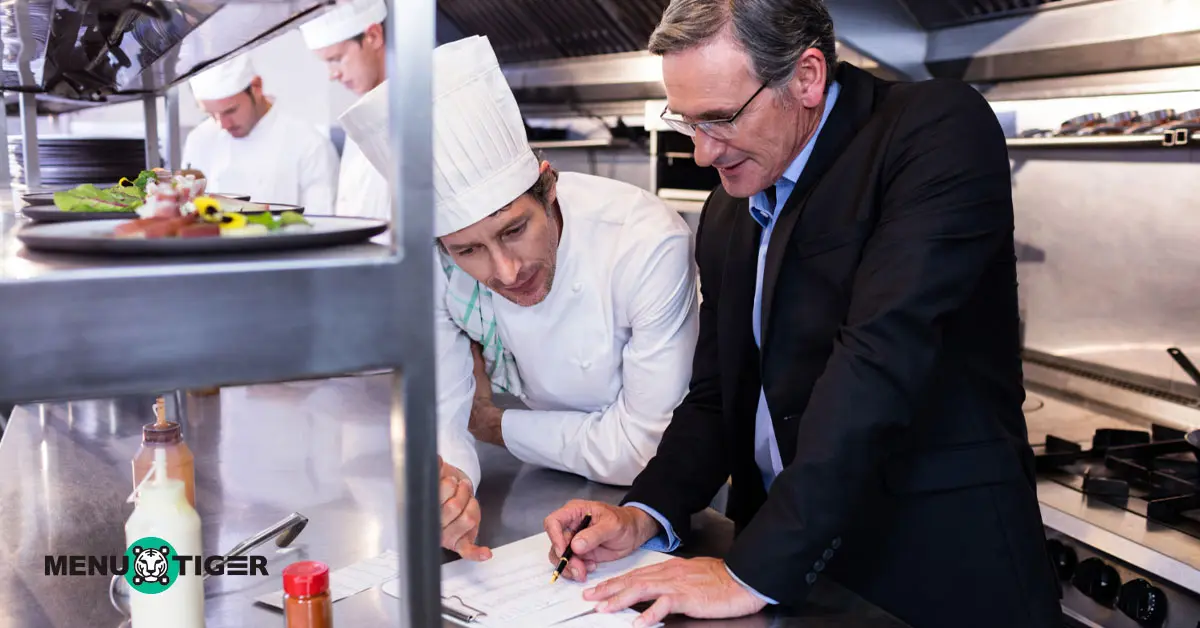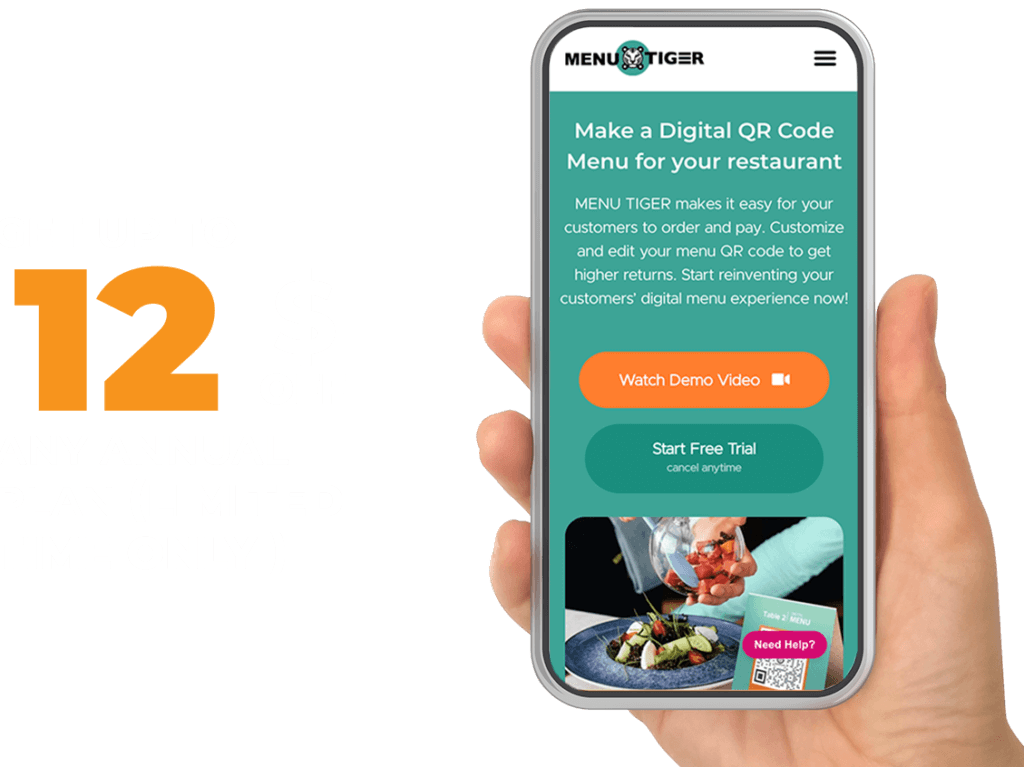A sobering study by Ohio State University found that approximately 60% of restaurants close within their first year, with nearly 80% shutting down within five years. And poor management is often cited as the root cause.
The foundation of a great restaurant is simply great management, which starts with the heart of its operation — the kitchen.
Kitchen management is crucial as it keeps everything running smoothly, from your operations to your profit. If you want to see the result, this article will guide you on managing a kitchen effectively, covering key duties, restaurant order management solutions, and best practices.
Table of Contents
ToggleWhat is kitchen management?
Kitchen management is the act of supervising all kitchen operations.
Its core functions are to maximize restaurant profit margin and operational efficiency, secure financial success, and uphold excellence in culinary quality.
If you wonder why this is essential, watch Kitchen Nightmares, a YouTube series featuring Gordon Ramsay that highlights restaurant failures. It provides compilations of why restaurants can experience a major downfall.
Often, these establishments struggle due to unhygienic practices, low-quality food, poor financial management, staff conflict, and overall poor management in the kitchen.
Essentially, managing a kitchen ensures that all these areas are properly addressed and supervised, enabling the entire Back of the House (BOH) to operate smoothly, so that the Front of the House (FOH) can deliver an excellent customer experience.
What are the duties of a kitchen manager?
Note: The list of kitchen manager job descriptions is based on research from Indeed, a reliable job listing platform.
According to research, their primary duties generally include:
1. Staff training and management
They are responsible for building and nurturing a high-performing culinary team. This involves recruiting new staff who align with the restaurant’s culture and providing comprehensive, hands-on training that extends beyond basic tasks.
2. Inventory and kitchen waste management
They keep track of all the ingredients and supplies on hand. They determine what’s needed, place orders with suppliers, and since one of the biggest money pits in a kitchen is food waste in restaurants and inefficient stock management, they ensure that food is received correctly and stored promptly to prevent waste.
3. Budget and cost control
The kitchen manager duties are detail-oriented and a financial watchdog. They don’t just look at the sales report; they dig deep into expenses. By tracking everything from utility bills to how much food gets thrown away, they pinpoint areas of potential waste.
4. Safety and sanitation compliance
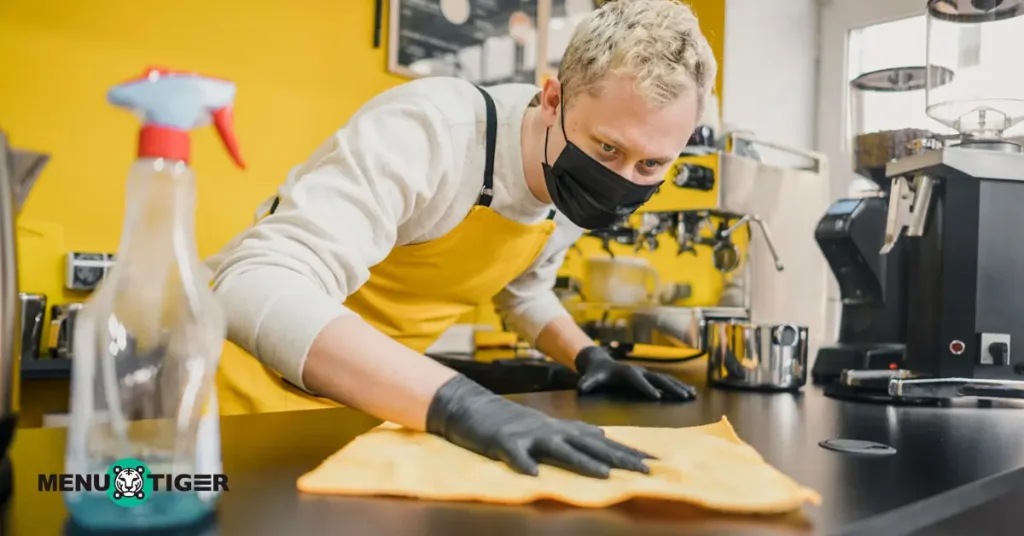
The manager ensures the kitchen is spotlessly clean and adheres to all health department regulations.
They make sure staff wear proper gear, handle food safely to prevent cross-contamination, and that equipment is well-maintained and clean.
5. Scheduling and labor management
The manager addresses this by creating smart and fair staff schedules.
They use past sales data to predict exactly how many cooks and prep staff they need for any given shift, making sure labor costs are optimized without sacrificing service quality.
6. Communication and coordination
They act as the main link between the kitchen (back-of-house) and the serving staff (front-of-house).
This facilitates smooth communication regarding daily specials, food shortages, customer allergies, and any issues with orders.
This ensures the achievement of the restaurant goals you have.
7. Workflow management
They are constantly looking at the workflow, from where the plates are stored to how the cooks move around the line. They eliminate those annoying slowdowns and ensure every customer gets their food out quickly, hot, and right.
8. Menu planning and development
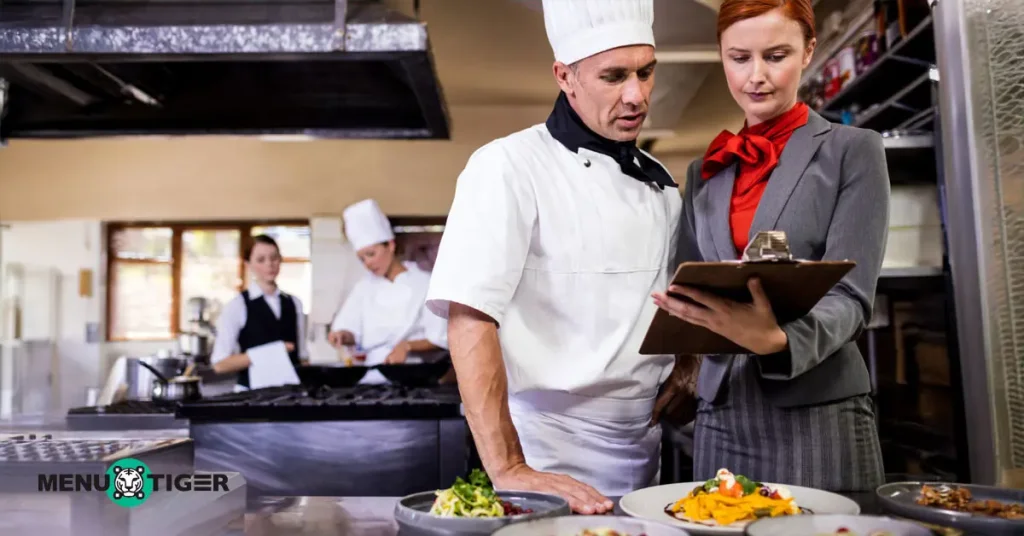
They work with the Head Chef to test new recipes, calculate the cost of new dishes, and decide what items to keep or remove from the menu based on popularity and profit.

The best kitchen management software solution
Managing a kitchen is an overwhelming task. Imagine having to micromanage every operation from ordering, preparation, communication, to analytics.
Keep in mind that every smooth operation comes from a smart decision. It is not about who works the hardest, but about working smart.
As an owner, eliminate the toxic mindset of “I’m paying them to do this job.” Instead, help your staff achieve the high standards of your restaurant with restaurant management software solutions:
1. Kitchen Display System (KDS)
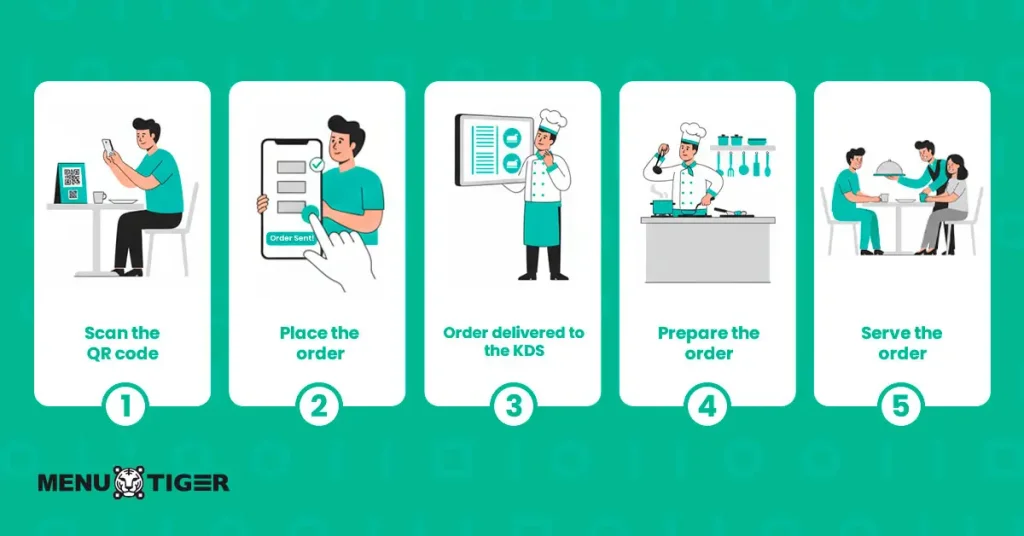
Long before the impact of technological advancements was felt, paper tickets were widely used, and even today, many restaurants still rely on them.
However, in the worst case, these paper tickets can easily be misplaced, damaged, or even lost during busy hours.
Now, how would you explain to the customer that the order wasn’t served because the order was never there in the first place?
Well, it’s just a matter of using the right tools.
A kitchen display system provides a solution to the problems caused by paper tickets by replacing pen and paper with a digital interface.
Imagine the convenience it provides to both staff and customers: they place their orders through a QR code menu at their table, and the order is reflected immediately in the kitchen, with no hardware lock-in needed.
That’s it! No misplaced tickets, less staff efforts, just pure convenience.
2. Menu management
“For a while, ma’am/sir, I’m just going to check if it’s available.”
“I am sorry, it seems that item is currently unavailable..”
Just a quick question: Does your staff still perform this task manually? If so, using a smart menu can manage this automatically with just a few taps.
A menu management system is built with features that allow restaurants to update item availability in real-time, change prices, highlight specials, and customize menus for different times of day, locations, or customer preferences. No need for reprints.
3. Accounting integration
How many hours does your back-office staff spend every month manually reconciling sales and data before sending it all over to your accountant or inputting it into your accounting software?
Restaurant technology eliminates this time sink through accounting integration. This crucial feature in a restaurant order management system automatically and accurately synchronizes all sales with the accounting feature without the need to switch to a different platform.
It is an all-in-one solution that helps your staff budget and control costs.
4. Digital menu
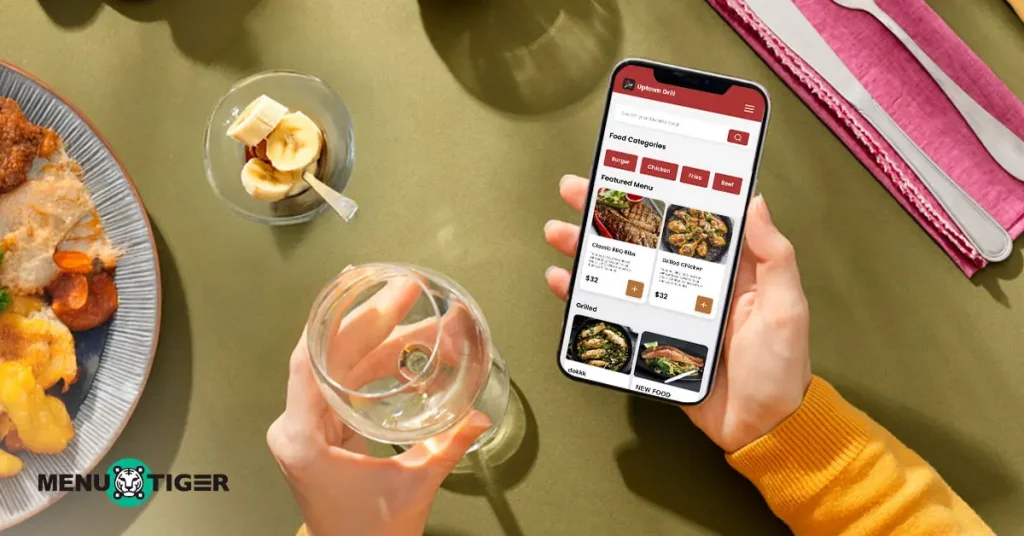
Have a little empathy for your staff and help them by reducing their workload. Stop making them jot down every customer’s order and let them focus on what truly matters, providing genuine hospitality.
According to Witmeg, 73% of diners agree that restaurant technology improves their overall dining experience.
With that said, let the customer scan a QR code and access a digital menu right from their own device.
This allows them to browse the menu at their own pace, place their orders directly, and even make payments without waiting for staff assistance.
The core benefit? Complete hygiene, instant accessibility, and a modern, professional impression that delights the diners who value tech-enhanced experiences.
5. Reporting and analytics
How can you make informed decisions when you’re drowning in data and unsure which numbers truly matter?
Whenever possible, look for a smart order management system that handles reporting and analytics for you.
Choose one that automatically displays key insights, such as total orders, total revenue, total customer count, and the best-selling items, right on the dashboard.
This enables your staff to identify which items need to be restocked.
In addition, look for a system that collects essential customer details such as email addresses and phone numbers, so your staff can easily reach out for follow-ups, loyalty programs, or personalized marketing efforts.
6. Marketing
While many restaurants see technology as just an operational tool, the best software is a powerful marketing engine.
Imagine your staff having to stand outside the restaurant, trying to convince passersby to try a special or a new dish. It can be tiring and frustrating, especially when people simply are not interested.
According to Zipdo report on marketing in the food industry statistics 2025, 50% consumers follow restaurant on social media to be updated with promotions.
Instead, look for software that allows you to create a restaurant website where you can promote your specials, collect customer feedback and surveys, and gather valuable customer information.
This way, your marketing efforts become automated, data-driven, and far more effective than traditional methods.
7. Restaurant waiter call button
This feature reduces the need to manage every customer closely.
A restaurant waiter call button allows diners to request assistance with just one press.
Instead of waving for attention or waiting for a server to pass by, customers can signal exactly what they need, whether it’s ordering, requesting the bill, or asking for water.
For staff, this means fewer interruptions, a clearer sense of priority, and it helps maintain a smooth workflow while improving response times.
8. Smart integration
While some quality and budget-friendly software may not include built-in scheduling or inventory management features, they often offer extensive integrations.
Look for software with Zapier integration, which allows you to connect your kitchen management system to tools like Google Calendar for scheduling and inventory tracking apps or spreadsheets for stock management.
Smart integration turns your software into a central hub for both labor and inventory management, linking operational data in real time across multiple tools.
It eliminates the need for repetitive manual work, keeps your kitchen running smoothly, and helps you make data-driven decisions with minimal effort.

Why do you need management systems for your kitchen?
- According to Emergen Research, a market intelligence firm, restaurants using integrated technology report a 12–18% higher profit margin compared to the traditional method
- Cherry Berry RMS, a restaurant software provider, found that manual order errors occur at a rate of 12–15%, which digital systems can significantly reduce.
- The National Restaurant Association, a leading industry group, cited by MoldStud, a software solutions company, reported a 20% boost in productivity and a 15% cut in food waste with kitchen technology.
- Task, a restaurant management platform, noted that over half of restaurateurs face high food costs, with 22–33 billion pounds of food wasted annually in the U.S.
- According to ZipDo, a data research firm, a staggering 90% of customers prefer online menus over static menus.
- A Lavu study, from a POS technology company, found that kitchen display systems can cut order errors by up to 90%.
The benefits of smart systems for your kitchen

The advantages of management tools are really about taking the pressure off the human mind and letting the technology handle the meticulous, repetitive stuff, so the staff can focus on what they do best.
1. Drastically improved order accuracy and speed
A restaurant order system helps ensure the right orders get to the right stations quickly and correctly, virtually eliminating those messy handwritten tickets and miscommunications.
Orders from the front-of-house (POS) immediately display on kitchen screens (KDS – Kitchen Display Systems).
This means less time yelling, fewer mistakes, and guests getting their food faster and exactly as they ordered it.
2. Better food waste and inventory control
According to RTS, a waste and recycling technology company, the food waste in America is nearly 60 million tons (120 billion pounds) of food each year—about 40% of the U.S. food supply, or 325 pounds per person.
By tracking sales data in real-time, the system can predict peak demand, help with smart ordering, and pinpoint exactly when and why food is being wasted.
You move away from guessing how much to prep and toward data-driven decisions, which saves a ton of money over time by reducing spoilage.
3. Enhanced data-driven decision making
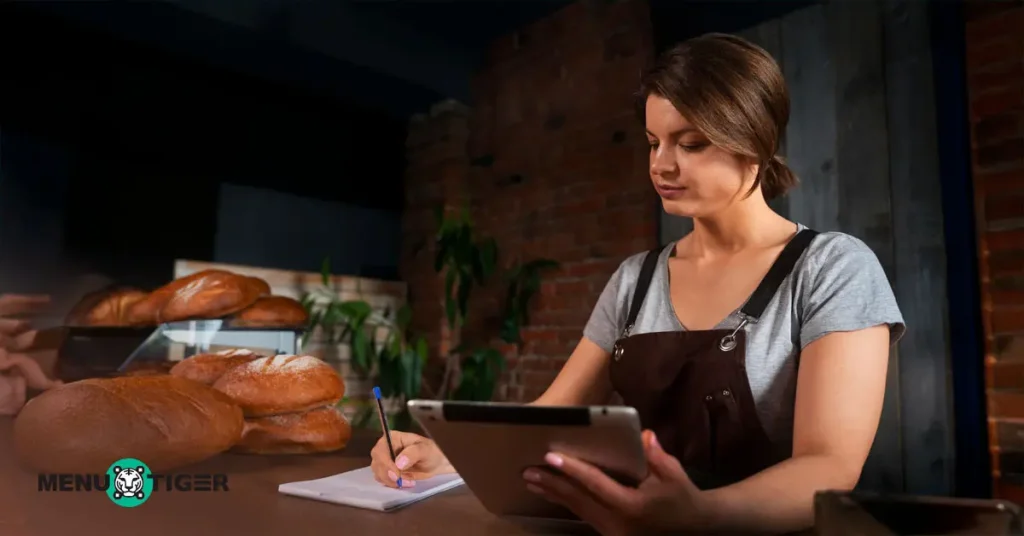
These systems collect mountains of valuable information about your operations that would be impossible to gather manually.
You gain deep insights into key metrics, including peak business hours, the most profitable menu items, average preparation times for various dishes, and individual employee performance.
4. Seamless compliance and consistency
Maintaining high health and restaurant safety standards and ensuring every dish tastes the same, no matter who cooks it, is essential.
Instead of scribbling down freezer temperatures on a clipboard (which can easily get lost or misread), many systems automatically log or prompt staff to log crucial data like holding times and temperatures.
When the health inspector walks in, you don’t fumble for paperwork; you just pull up an undeniable, digital log of your compliance history.
That makes things significantly less stressful because you have proof that food safety standards are consistently being met.
5. Smarter staffing and labor cost control
Since the system knows exactly when your peak times are, you can schedule staff precisely where and when they are needed most.
This prevents over-staffing during slow periods and under-staffing during the rush, making sure every dollar spent on labor is justified.
Best practices for running a successful restaurant kitchen
1. Master your mise en place
Mise en place, the French term for “everything in its place”
This means ensuring every cook has all their tools (spatulas, towels, tongs), their speed racks stocked with everything they need for the first three hours of service, and clear product rotation in their small line fridges.
The station itself must be set up identically for every shift to eliminate confusion.
2. Standardize everything
SOPs (Standard Operating Procedures) aren’t just for cooking. They cover receiving deliveries, taking temperatures, portioning, equipment cleaning, and dating products.
Use a recipe binder or digital system that includes a photo of the final plate, exact weights for every ingredient, and the step-by-step process.
If an employee is unsure, the SOP is their answer, not you.
3. Implement strict inventory and cost control
Move beyond basic counting. Use an inventory sheet that separates goods by location (walk-in, dry storage, freezer) and tracks the unit cost and usage rate.
Conduct weekly physical inventories and compare them to sales data to calculate your actual food cost percentage.
This comparison will highlight the “hidden” losses from waste and theft that a simple ordering sheet won’t catch.
4. Apply the zero tolerance for waste principle
Every piece of food that’s thrown out must be logged.
Implement a waste sheet or digital tracker where staff record what was wasted (example, 5 lbs of lettuce), why it was wasted (over-prepped, spoiled, dropped), and the calculated dollar value.
Review this “spoilage scorecard” daily to pinpoint problem areas (is a particular cook over-prepping? Is your ordering off?).
5. Be smart in scheduling based on labor percentage
Don’t just schedule based on who’s available; schedule based on your target labor cost percentage (example, 25%).
Use historical sales data to project demand every 30 minutes.
Schedule your heaviest hitters for the busiest windows and use minimum staffing during slow periods.
Track actual labor dollars vs. projected sales every day and adjust immediately.
6. Prepare a rigorous and documented staff training
Training must be structured. Use a training manual and a checklist system built by a dedicated SOP creator so every station, task, and safety step is documented the same way every time.
New hires shouldn’t touch a knife until they’ve passed a basic food safety quiz and shadowed an experienced cook.
Certify your staff on their stations, and don’t let them work unsupervised until they can execute the SOPs perfectly three shifts in a row.
7. Lead with composure and intentional feedback
Your role is part coach, part therapist, and part expediter.
Instead of reacting emotionally when things go wrong, use a three-step feedback model:
- Identify the specific mistake
- Explain the impact (example, it slowed down the whole line),
- Coach the solution based on the SOP. Be the calm energy that cuts through the chaos during the dinner rush.
8. Optimize your kitchen workflow and equipment
Constantly evaluate efficiency. The flow should be a logical sequence: storage, prep, line, service window.
Conduct regular equipment audits; a broken hinge on a fridge or a slow oven can cause massive delays and spoilage.
Budget for preventative maintenance; a few hundred dollars now saves thousands when a unit fails mid-service.
9. Enforce next-level food safety and sanitation
Food safety is a full-time, active management duty. Use color-coded cutting boards and utensils to distinguish between raw and cooked items.
Implement temperature logs for walk-ins, freezers, and hot-holding equipment that are checked and signed off on multiple times per shift.
Designate “clean as you go” zones and a detailed deep cleaning schedule that goes beyond daily wipe-downs (example, hood filters, walk-in coil cleaning).
10. Cultivate FOH/BOH collaboration
The kitchen and the front-of-house must operate as one team. Hold joint pre-shift meetings to discuss server knowledge of specials and kitchen capacity.
Use a Kitchen Display System (KDS) to relay real-time information, but also establish clear, non-verbal signals for common communication (example, “hands-up” for hot plates, or a “waiting for” cue).
Servers must respect BOH workflow, and BOH must treat FOH communication as critical for customer satisfaction.

The kitchen is your field, manage it like a pro!
The high failure rate of new restaurants is a stark reminder that passion for food is never enough. Long-term success is a product of disciplined organization.
By prioritizing strong kitchen management, bolstered by smart technology like a modern restaurant ordering system and digital tracking tools, owners and managers gain the necessary control over costs, quality, and consistency.
Your kitchen is the factory, and the management is the system that keeps the assembly line running perfectly.
Manage it like a pro, and watch your profits grow.
FAQs
A kitchen management system is a digital tool that helps restaurants keep their kitchen running smoothly. It handles tasks like tracking orders, managing inventory, scheduling staff, organizing food preparation, and generating reports, all in one software.
The main objectives of kitchen management are to maintain the highest standards across all kitchen operations. This focuses on efficiency, quality and safety, and cost control, ensuring the kitchen runs smoothly while staying aligned with these key goals.

